

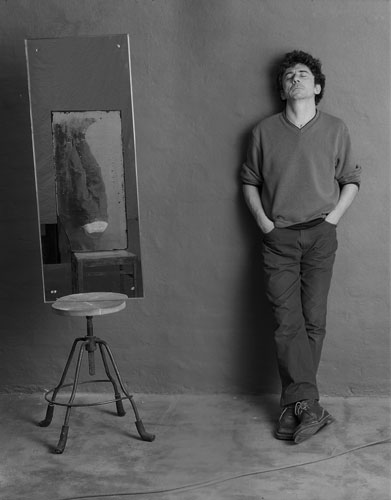
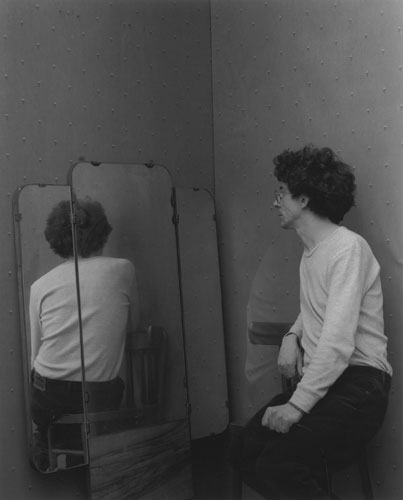
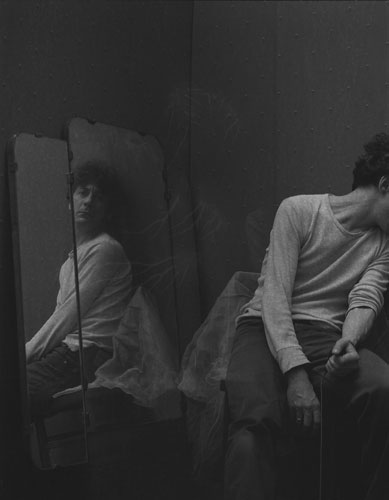
Paweł Żak's Magical Mirror of Photography
This meaningful use of the mirror in the series recalls a doubled metaphor of photography as both mirror and window. It has to do with two aspects of the photographic image. The first one involves pure sensuality of a visual phenomenon as an optical reflection of the external world caught in the mirror of photography. The second one concerns its psychological aspect which refers to what one can see through the window of the picture’s frame, what one can study and know, understand better or merely touch or suggest. The image of reality isolated and contained in a photographic frame becomes a window which creates the frames of perception, steering it outside and inside and allowing for analysis and reflection on what we can see. The mirror gives us only a flat image that reflects the external world, while the window creates a frame that lets us deeply penetrate a fragment of otherwise ungraspable reality which as a whole cannot be contained by the human eye.
Both these metaphors refer to transitory images, caught in a moment when one looks in the mirror or through the window. A photograph is a registered look of the photographer. It can preserve the superficial image of the state of things which is legible, clear, simple and unambiguous - like the reflection in the mirror. It can also be directed "inside” and let us see important things, deserving close attention and longer consideration. This is what Paweł Żak aims at when he comes into specific contact with his "close acquaintance”. Here the mirror and the mirror image become only elements of an ontologically complicated image. They serve to articulate the contents of what Żak calls to the attention of the viewer through the frame of the window/photograph. The series called Close Acquaintance is a momentary and fragmentary inquiry into the world created by the author. The close acquaintance of the title can be recognized and examined by means of images: a mirror image and a photographic image.
The image seen in the mirror does not create distance towards one’s image - as it is an every-day, domesticated image. Usually we do not feel any intense estrangement towards the person in the mirror, since it is someone we know quite well. However, the mirror image is transitory - it is enough to move away from the mirror in order for it to disappear. Then nothing of our image remains in the mirror, it becomes a flat, dead surface, devoid of any sign of our transitory presence. The photographic image, however, is something permanent, a physical trace of one’s presence in the "here-and-now”. We can put this image away, hide it and never come in contact with it again, but we know that it exists somewhere and that we can return to it at any given time as to something unalterable, permanent, stable and tangible. The mirror, on the other hand, lets us come into transitory contact, into a kind of "mirror interaction” with our image, an interaction that is both physical and psychological and creates an atmosphere of presence. In the face of a photographic image we are alone, we do not come into active contact or interaction with it - which also produces the feeling of distance and strangeness. In the mirror image we rather expect the confirmation of what we know about ourselves, what we expect of ourselves or what we think we will see. We look at a photograph hoping for a surprise which will astonish us by telling us something about ourselves that we do not yet know. Paweł Żak links these two images by means of this kind of hope, at the same time broadening his knowledge of himself.
The photographic image has one very valuable feature, typical for all media images: it lets us register things that we cannot see in ourselves in the course of everyday perception. Thus it makes it possible to look at ourselves from a distance through a camera lens. What the camera registers and what reaches our consciousness by means of direct perception in the form of images is different, if only in terms of the nature of those two kinds of images, in spite of the fact that the objects of registration and perception are identical. The photographic image is something fragmentary and static, unalterable and registered along with its contents. The images that reach our perception are continuous and dynamic, but changeable and transitory, like mirror images. Our perceptive apparatus is unable to preserve the fragmentary, static image that could become the object of a detailed analysis of content, form or its relations with the outside world.
This difference of the media image as compared with the mental image is felt most strongly precisely in the registered image of our own person. Looking at our photograph we experience this strange and disturbing feeling that the person whose image was registered by the camera is a stranger. We know that we are this person; however, each of us confronting our own images is someone who comes into contact with a "close stranger” because our image of ourselves is confronted with the objective image, registered by the camera. This situation repeats itself each time in confrontation with new images, regardless of the fact how many of our own images we have seen up till now. It is not because we do not know what we look like or because these new images are exceptional but because our own image creates a specific psychological relation. This relation also makes us realize (or perhaps only gives us a paradoxical feeling) that the external world is something physically real because it can be registered in an image and that we are a part of this world from which we differ at every moment of our existence. Being physically in the world, psychologically we feel that we are external to it. Looking at a transitory image in the mirror and at the permanent photographic image we sensually and mentally experience the uniqueness of our individual existence and the duality of physical and psychological being. The time-shift between a real situation that is the object of registration and the perception of the image itself fortifies this feeling. Time stopped in its tracks and the flat, two-dimensional representation of past reality, constrained by the four sides of the picture, create the feeling of momentary distance also with regard to our own image, and through it also with regard to ourselves. This is also one of the reasons for the feeling of estrangement we get towards our own image seen in the photograph. The photographic image creating the distance of time that has passed since the moment of its production and the distance which results from its technical, mechanical character seems to show us a person we know, though he/she is not as close to us as the person from the mirror image. The title of the series discussed here refers precisely to this feeling and tries to communicate it to the viewer by means of a photograph.
The works of Paweł Żak demonstrate a certain surprising situation. The mirror of photography shows something that a real mirror cannot show, an image that contains two different but simultaneous images of one person. Although certain manipulations allow us to achieve doubled or multiplied reflections of the model, every one of them remains within an unalterable, mechanical, "subdued” relation with regard to all the given actions of the model because it repeats them faithfully. In the works by Żak each of those two image representations of one and the same person acts regardless of each other. Manipulating the images has enabled the artist to move beyond the physical limitations of a mirror image. It liberated the mirror image and enabled it to come into being regardless of the actions of the person whose image is contained in the picture next to the mirror. It also allowed Żak to present a specific relation, a dialogue with himself, which is not possible as far as the mirror image or an ordinary photograph is concerned since it is conducted in the sphere of psychology. The mirror of a slightly manipulated photograph serves to lead the viewer to the window of the photograph and to make him look through it into the depths of the image of the given created situation. This makes the rectangle of the frame become the rectangle of a theatrical stage on which an unusual monodrama takes place. We see its action only fragmentarily but cannot see it a continuous series of events. We only see it in single, individual pictures showing us fragments of scenes but since we do not know them completely, we cannot grasp the whole of the narration. Theatricalization present in almost all of Żak’s earlier works is definitely most intense in this case. However, we are not really the viewers of this "performance” since the stage situations presented have already taken place and the performance has closed. What we see is rather its specific documentation, both incomplete and selective. It is on this foundation that we have to formulate an opinion as to the contents and the message of a performance which took place some other time somewhere else.
In the first pictures of the series the double presence concerns characters who are closer to each other, dressed identically and with identical hairdos. They resemble a doubled mirror reflection. In the final part of the series the differences between models gradually become more significant. The characters differ with regard to their dress and appearance, in spite of the fact that we can still recognize in them one and the same person. Their actions become independent of each other and do not remain in such a close, "mirror” relation. Successive pictures show us these differences more and more clearly along with the gradually growing distance between the models. In some photographs the mirror disappears altogether. This enhances the feeling of mutual distancing and alienation of the characters. Earlier the mirror image still linked the two figures in a close, although perhaps only purely physical relation. Situations in which there is no mirror break this connection and create a new one, based on the autonomy of the characters’ actions.
The Close Acquaintance series is a metaphorical story of meetings with one’s self. We experience such encounters sporadically in spite of the fact that we are in contact with ourselves every hour of the day. Situations in which we conduct an internal, intimate dialogue with ourselves are always connected with situations that violate our daily routine. Wanting to conduct such a dialogue with oneself that could help us in these situations we put our actions, anxieties and uncertainties on external display. We try to look at them from the external perspective as if they were not ours. Photographs and the image of the mirror enable Paweł Żak to make exactly this kind of attempts at deep introspection. His works speak through unusual images of individual episodes of the internal dialogue that accompanies our existence. They are fragmentary relations of the struggles whose traces usually cannot be seen from the outside. And they deal with a universal problem: the problem of our self-consciousness, concerning the question of who we are in our own eyes.
Lech Lechowicz
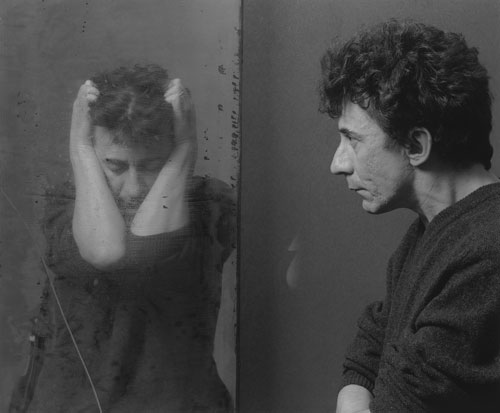
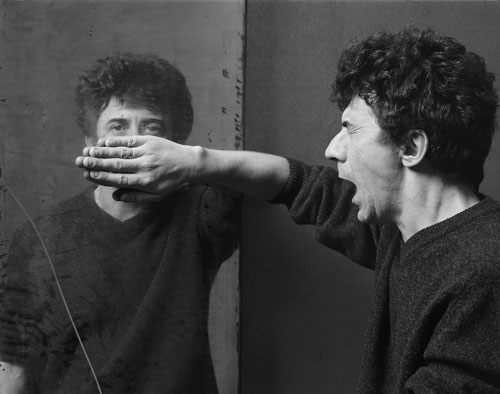
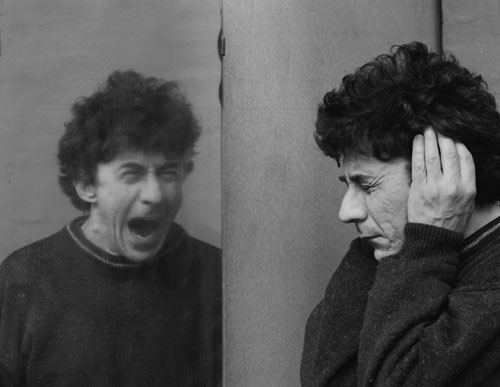
Next exhibition
28.11.2008
Copyright ©2008 Galeria FF ŁDK, Paweł Żak, Lech Lechowicz